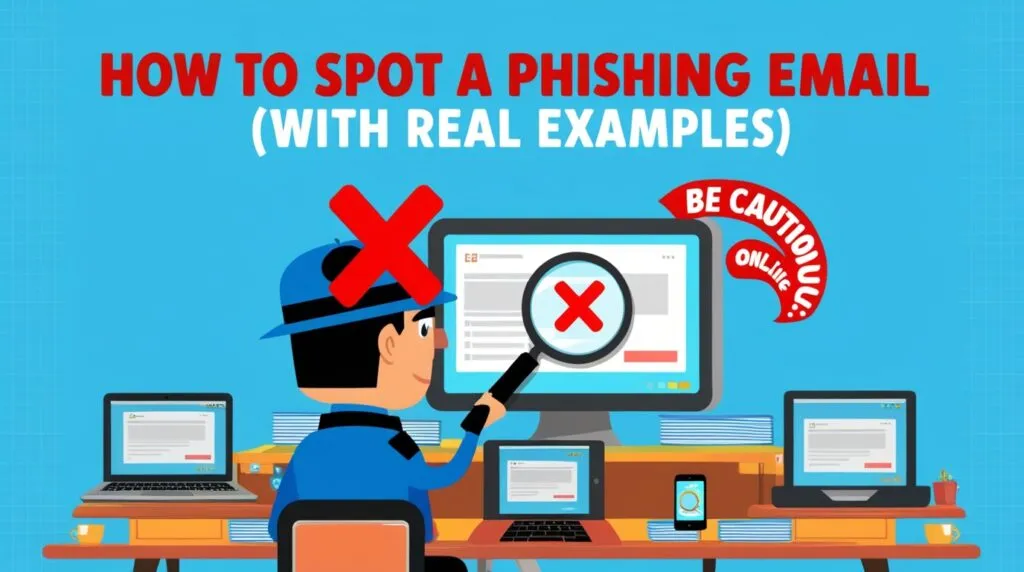Description
Learn how to spotphishing emailsbefore they trick you! We break downreal-world examples, red flags, and expert tips to keep your data safe in 2025.click here
Introduction
You check your inbox and see an urgent message:“Your account has been compromised—click here to secure it!”Your heart races. Is it real? Or a scam?
Phishing emails continue to become more frightening while attaining better effectiveness in their deceptive tactics. The starting point for 91% of cyberattacks will be phishing emails during the year 2025. There exists favorable news because you can defeat them. [how to spot phishing emails 2025]
In this guide, we’ll show you:
✔5 telltale signs of a phishing email(withreal screenshots!)
✔You can identify the techniques scammers use to manipulate people (their psychological manipulation methods)
✔Users should immediately take specific actions when they inadvertently fall victim to phishing links.
✔Real-world examples(so you’ll never fall for them)
By the end, you’ll spot phishing attemptslike a cybersecurity pro. Let’s dive in!
1. The 5 Dead-Giveaways of a Phishing Email
🚩 1. Suspicious Sender Address
Example:
“Amazon Support”support@amaz0n-security.com
✅Valid email communications always originate from domains that end with “@amazon.com” while rejecting every variation with misspellings of the domain name.
🔍Gather information about the domain because scammers create domains that slightly differ from legitimate ones (for example @paypa1.com versus @paypal.com).
[phishing email red flags]
🚩 2. Urgent or Threatening Language
Example:
The platform will lock your account within 24 hours unless you verify your identity right now.
✅Real companiesdon’t threaten immediate action.
🔍Panic activation by phishers forces you to make instinctive choices.
🚩 3. Generic Greetings
Example:
“Dear Valued Customer,”
✅Banks/servicesuseyour name(e.g.,“Hi, [Your Name]”).
🔍 If it’s impersonal,be suspicious.
🚩 4. Strange Links or Attachments
Example:
“Click here to update your billing info:http://bit.ly/3xY7fKk“
✅Hover over links(don’t click!) to see thereal URL.
🔍Shortened links (bit.ly, tinyurl)arered flags.
🚩 5. Poor Grammar & Spelling
Example:
“We detected suspicous activity in youre account.”
✅Big companieshave professional copywriters.
🔍Typos = scam99% of the time.

2. Real Phishing Email Examples (2025 Edition)
Example 1: Fake “Netflix” Subscription Scam
📧Subject:“Your Netflix subscription is on hold”
💬Body:“We couldn’t process your payment. Update your billing info now to avoid service interruption.”
🔴Red Flags:
- Sender:@netflix-support.org(real Netflix uses@netflix.com)
- Link goes tonetflix-billing.com(fake site)
- “how scammers trick you with phishing”
Example 2: “Bank Security Alert” Phish
📧Subject:“URGENT: Unauthorized login detected!”
💬Body:“Click below to secure your account immediately.”
🔴Red Flags:
- Nolast 4 digits of your account(real banks include this)
- Link leads tosecure-chase-bank.com(Chase’s real site ischase.com)
The “Bank Security Alert” Scam (How It Works)
You get an urgent email:
“Suspicious login detected! Click here to secure your Chase Bank account.”
It looks real—bank logo, professional formatting, even a fake “Case ID.” But it’s aphishing trap. Here’s how to spot it:
🚩 Red Flags in Fake Bank Alerts
- Sender Email is Off
- Example:“security@chase-bank.com“(real Chase uses@chase.com)
- Scammers useslight misspellings(e.g.,@bankofamerrica.com).
- No Personal Details
- Real banks includeyour name, last 4 digits of your account.
- Phishing emails say“Dear Customer”or“Valued Member.”
- Urgent Threats
- “Your account will be locked in 24 hours!”
- Real banksneverpressure you to act immediately.
- Suspicious Links
- Hover over the button—does it go tochase.comorchase-security-login.com?
- Scammers usebit.ly linksto hide fake URLs.
- Bad Grammar
- “We detected an unauthorised login.”
- Big banks haveflawless spelling.
Real Example (2025 Phishing Email)
📧Subject:“URGENT: Unauthorized Transaction on Your Account”
💬Body:
“We noticed a $1,287.50 payment from your account. If this wasn’t you,click hereto dispute it now.”
🔴Why It’s Fake:
- Sender:“security@chase-online.net“(not Chase’s real domain).
- Link leads tochase-account-verify.com(scam site).
What to Do If You Get One
- DO NOT click any links.
- Forward the email to your bank’s fraud department.
- Log in to your bank’s official app/website (not from the email).
- Enable two-factor authentication (2FA) for extra security.
Final Tip: Always Verify
If unsure,call your bank directly(use the number on their real website).
“Organizations that function as genuine banks do not request password information through electronic communication.”
3. Do If You Click a Phishing Link?
😨Don’t panic!Follow these steps:
- Disconnect from the internet(prevents malware spread).
- Users should execute a virus scan through either Windows Defender or Malwarebytes.
- Change passwords(starting with email & banking).
- Enable 2FA(adds extra security).
- Report the phishing email(forward toreportphishing@apwg.org).
4. How to Protect Yourself in 2025
🔒Pro tips to avoid phishing forever:
✔Use a password manager(auto-fillsonlyreal sites).
✔Enable email filters(Gmail & Outlook have phishing detection).
✔Verify suspicious emails(call the company directly).
✔Bookmark important sites(so you never click email links).
Conclusion: Stay One Step Ahead of Scammers
Phishing emailsonly work if you fall for them. With this awareness of warning signs you will identify them automatically.
Remember:
- Check sender addresses
- Never click urgent links
- When in doubt, verify


